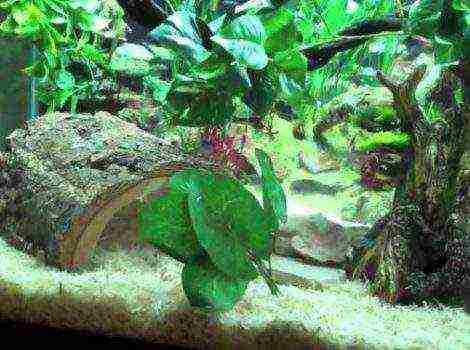Content
- 1 Types and varieties
- 2 Clivia: the nuances of growing
- 3 Home care
- 4 Reproduction of clivia
- 5 Pests and diseases - how to treat?
- 6 Why does clivia not bloom, leaves turn yellow, dry?
- 7 Receiving planting material
- 8 Requirement for dishes and soil
- 9 Clivia transplant at home
- 10 Getting clivia from seeds.
- 11 Home care for clivia
- 12 Video review
One of the most amazing indoor plants that can make a pleasant surprise to the grower in the season when the colorful variety of spring-summer flowers is lacking is clivia. Home care, built according to a competent scheme, leads to a phenomenon rarely found in other plants - flowering in the winter.
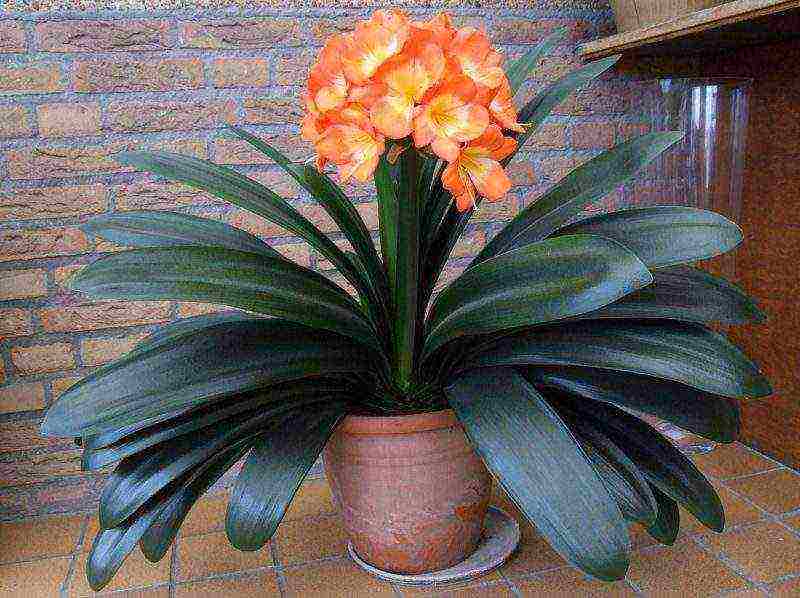
Clivia belongs to the amaryllis family. It comes from the subtropical climate zone of the South African coast. It has long, fleshy leaves, which are folded so densely at the base that they form a false stem. And from the center of the outlet at the height of winter, with proper care, a pedicel with beautiful bell-shaped flowers, collected in a neat umbrella, shoots out.
It takes some effort to enjoy this natural phenomenon. How do i care for cleavia? What kind of soil does she like? How to properly maintain it in winter? Is it possible to achieve re-flowering in the summer? We will talk about everything in order in this review.
Types and varieties
Flower varieties differ from each other only in the color of the petals, which can be red, orange, yellow, orange-yellow.
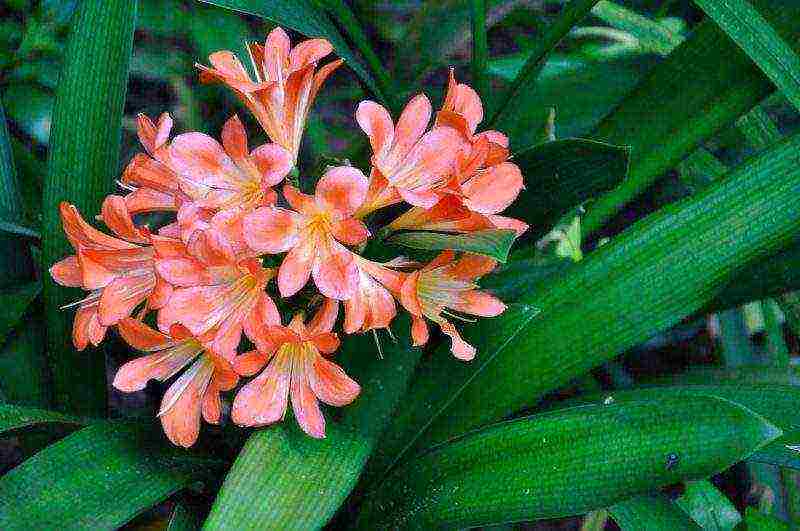
- Clivia cinnabar - the most common variety. The inflorescence contains 10 to 20 orange-red flowers.
- Clivia gardena differs from cinnabar in a slightly smaller number of flowers in the umbrella - usually up to 15, and also in a slightly higher peduncle.
- Clivia noble has a pale red color of petals and a curved perianth. Pedicel height ranges from 30 to 50 cm. The number of flowers in an inflorescence can exceed 20 pieces.
Clivia: the nuances of growing
The most important thing that clivia requires from its owner is a cool winter, so as not to deplete the bulb and give it the opportunity to lay a peduncle. During the flowering period, the temperature can be raised to room temperature. Another important point is to send the plant for "dosimovka" after flowering.
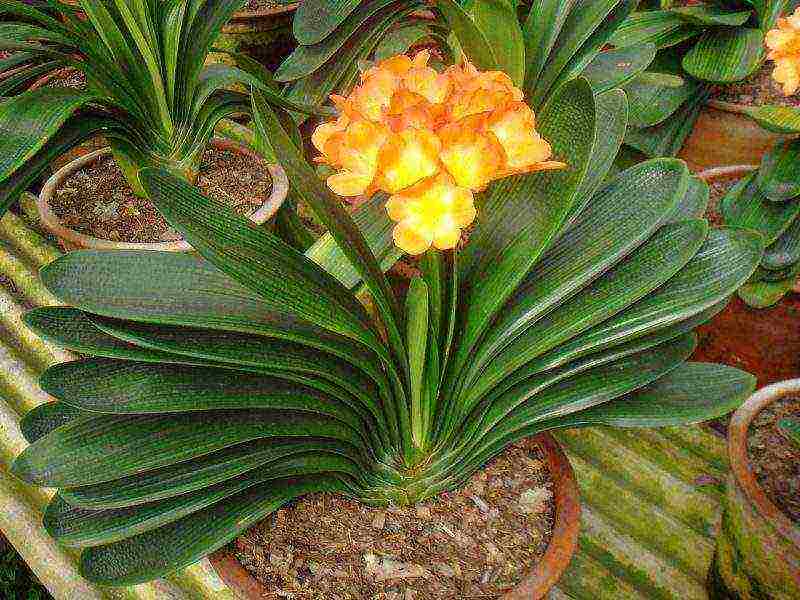
In the warm season, he likes to relax in the open field. During the period from late May to early August, it can noticeably grow and get stronger. Only it must be placed in the shade, since direct sunlight causes burns on the leaves! With the onset of the first cold August nights, it is brought into the room.
Home care
Most of all, clivia is demanding on the temperature regime. Also, do not pour it, as the bulbs easily rot in excessively moist soil.
Temperature features, lighting, humidity
- In the warm season, clivia needs temperatures of the order of 20-25 degrees, and in winter it loves coolness. At the end of autumn, if possible, it should be moved to a bright place with an air temperature of 14-17 degrees.
- The clivia flower loves bright diffused light, but prolonged exposure to direct sunlight is categorically unacceptable for it. Therefore, it is placed on the west, east, north-west and north-east windows. If necessary, it can be shaded using mesh material.
- The flower is not as picky about air humidity as some others. Strictly speaking, if the temperature conditions are observed, it is not necessary to additionally humidify the air. On dry summer days, can be sprayed in the morning and evening.
Soil requirements
Soil for clivia is prepared from equal parts of sod and leafy soil with the addition of a small amount of sand, preferably coarse-grained. It is important that there is a drain hole in the pot, and at the bottom before planting the plant there is a drainage layer of pebbles, expanded clay, stones or at least coarse sand.

You can also use commercially available bulb soil, which, however, is best mixed with fertile garden or forest soil in a one-to-one ratio.
Watering and feeding
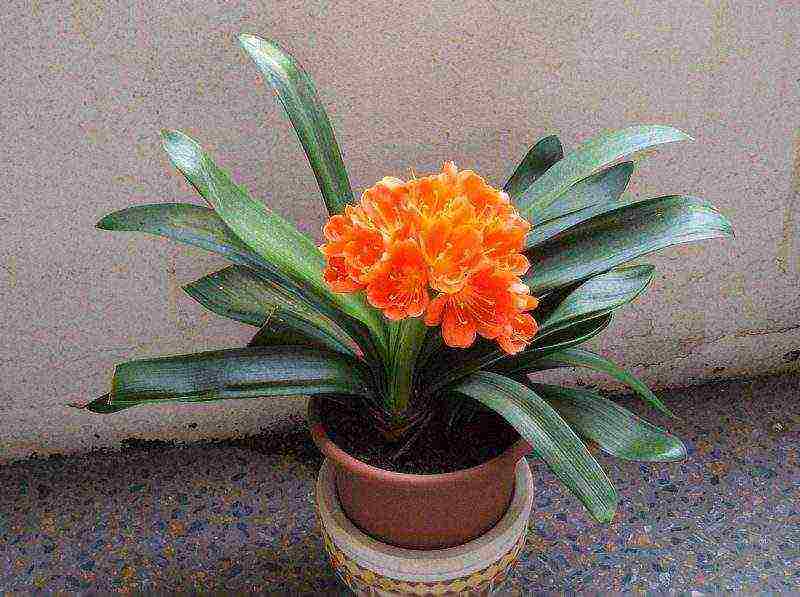
- Moisten the soil should be moderate, avoiding bays. This flower is at risk for the development of root and root rot due to overflow.
- The plant is fed only during the period of active growth, that is, in spring and summer, with a frequency of 1-2 times a month. Suitable for this purpose universal complex organic fertilizers: "Giant", "Ideal", "Breadwinner". You can also use mineral fertilizers: dissolve superphosphate, potassium nitrate and urea in approximately equal proportions (slightly less urea) in accordance with the instructions on the package. It is better not to overfeed with nitrogen fertilizers, as this will lead to a rapid growth of the green mass without flowering.
Once you can feed with potash fertilizers in winter at the time of peduncle formation. In general, from autumn to early spring, top dressing cannot be applied.
Flowering plant
A distinctive feature of clivia is winter flowering. It's so nice to admire the beautiful flowers on gray winter evenings. From a rosette of elongated leaves in the interval between January and March, she throws out an arrow, on which flowers are formed, resembling bells in shape. Their number can range from a couple of pieces to several dozen. The color of the petals is usually red, red-pink, less often yellow. You can admire this beauty for 20-30 days while flowering continues.
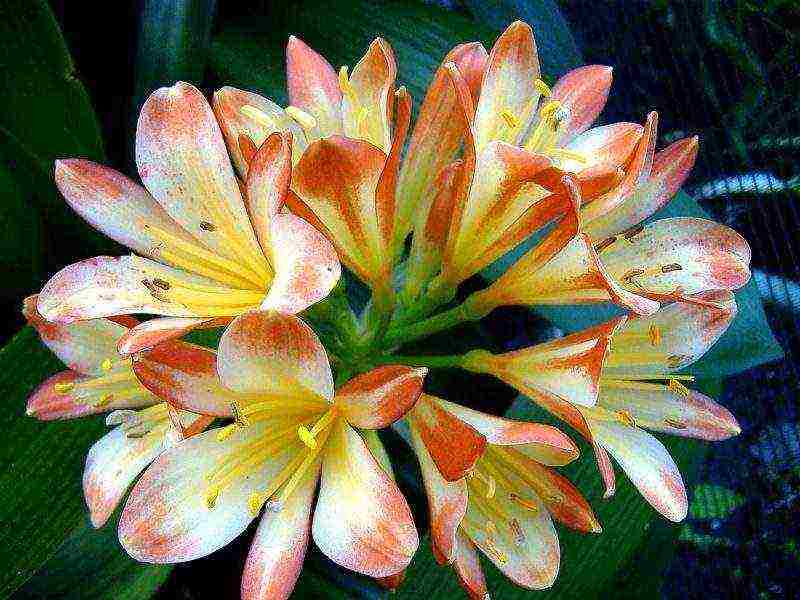
During the dormant period, clivia passes shortly after flowering, that is, in the second half of winter or early March.
Peculiarity! A plant with a peduncle that has appeared should not be rearranged to a new place, otherwise the buds will fall off.
Flower transplant
It is worth replanting this bulbous plant only when absolutely necessary, since the damaged roots easily rot. The exception is young specimens, which in the first 2-3 years of life can be reloaded every year. The main criterion indicating the onset of an extreme case: the roots are falling out of the drainage hole or they are braided with an earthen ball so tightly that they do not fit into the pot.
When transplanting, they try not to destroy the earthen lump. The new tank should be slightly larger than the previous one and not be inferior to it in terms of the quality of the drainage.
Very old plants, especially those older than 10 years, can not be transplanted until the end of life, but only annually replace the topsoil with new, fertile soil.
Winter care
In winter, when kept cool, clivia does not need frequent watering. You can moisten the soil only 1-2 times a month as it dries out.

We must not forget that at temperatures below +12, clivia dies! It is desirable that she winters at temperatures of +14 ... +17 degrees.
When a peduncle appears, the temperature is raised to 18-20 degrees. A cool windowsill works well for this, but no drafts! After the flowers wither, the plant is returned to the coolness until March.
Reproduction of clivia
Clivia reproduces in two main ways:
- Most often, clivia is propagated by baby bulbs, which are formed in large numbers around adult plants. They should be dug out as carefully as possible in order to damage as little as possible the roots of the mother plant.
- Planting seeds. True, seed plants bloom only after 2-3 years, but this does not stop amateurs. One more nuance: only adult specimens over eight years old can give seeds! It should also be taken into account that the formation of ovaries is possible only with cross-pollination. But if it is possible to grow the planting material, then it will not be difficult to propagate the flower.
The main thing is to remember that the seeds quickly lose their germination after harvesting, so they should be sown immediately.
The seeding and growing procedure is standard for most ornamental plants:
- Prepare standard soil and fill it into shallow containers with drainage holes.
- Seeds are spread over the surface of the soil mixture, slightly pressed, moisten the earth from a spray bottle and cover the containers with polyethylene or a mini-greenhouse and leave in a bright room with room temperature.
- The first shoots will appear in 3-4 weeks. When they are a little older, you can plant them in small pots.
Pests and diseases - how to treat?
Of the pests of clivia, scale insects and mealybugs love to eat.

- Shields resemble strange dark brown motionless growths ranging in diameter from a few millimeters to a centimeter.
- Mealybugs Are small white insects that like to settle in the axils of the leaves.
Both pests are well removed by Aktara and Aktellik. Aktara is used not only for spraying the affected plants, but also for watering the soil. The active ingredients of this drug are harmless to plants, but toxic to pests.

Of the fungal diseases, most often the plant suffers from root rot and bulb decay. Leaves with rotting of the root system become brown and wither. Unfortunately, the process can be stopped only at an early stage, when the symptoms are just beginning to appear. To do this, the flower is removed from the pot, its roots are washed in warm water and processed with Fitosporin. Rotten areas are ruthlessly removed, and the cuts are sprinkled with charcoal (wood or activated).
Why does clivia not bloom, leaves turn yellow, dry?
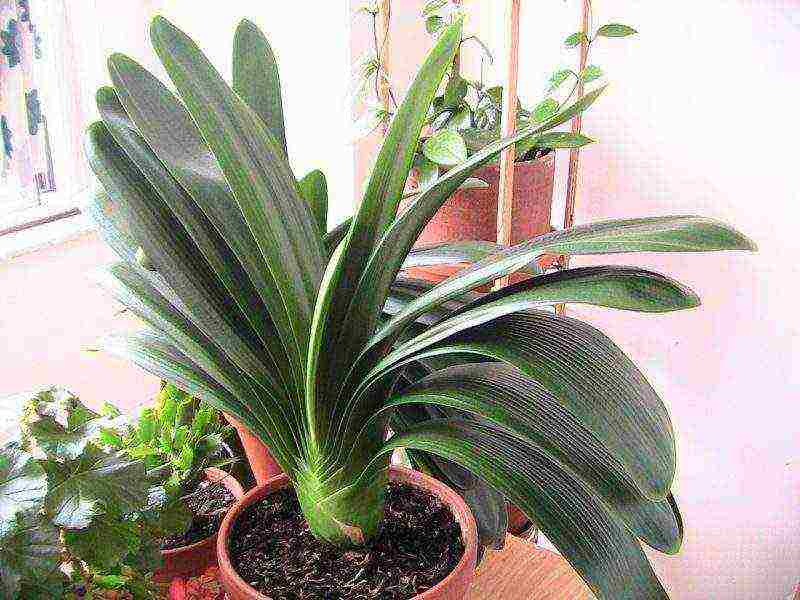
Why clivia does not bloom depends on several factors.
- To lay the buds, the plant needs winter coolness.
- The consequences of the gulf, or, conversely, the drying out of the earth, may affect.
- A lot of energy can be taken away by baby bulbs, which it makes sense to plant when they grow 3-4 leaves.
Important! If the leaves turn brown during overflow, then with a lack of water, their tips turn yellow and dry. Therefore, in winter, you need to regularly visit and check the condition of the flower: suddenly it's time to water.
Those who do not like winter for its dullness and monotony should definitely get a clivia. Yes, it will require attention to itself, but its abundant and spectacular flowering will cheer you up and help you wait for a warm spring.
 The tropical flower Kaffir lily has long taken root on windowsills, and is loved by flower growers. Reproduction of clivia at home is carried out by root suckers and seeds. It has short fleshy rhizomes, which, under good conditions, quickly give rise to lateral rosettes and create lawns. In captivity, the flower is propagated when transplanted into a new container. Clivia can be grown from seeds obtained from flowering plants after pollination.
The tropical flower Kaffir lily has long taken root on windowsills, and is loved by flower growers. Reproduction of clivia at home is carried out by root suckers and seeds. It has short fleshy rhizomes, which, under good conditions, quickly give rise to lateral rosettes and create lawns. In captivity, the flower is propagated when transplanted into a new container. Clivia can be grown from seeds obtained from flowering plants after pollination.
Receiving planting material
In a cramped root pot, there is not enough space. If you take a large dish while the roots fill it, there will be no flowering. In a close pots of fast-growing clivia, a transplant is necessary. A plant that has entered the time of flowering forms shoots around, which are separated from the mother bush at the time of transplantation.
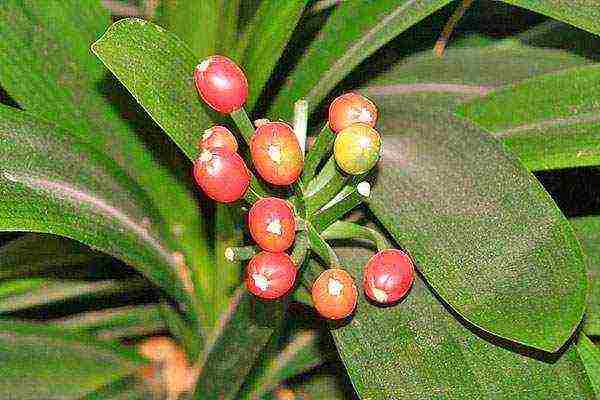 If, during flowering, cross-pollination is performed, then large berries are formed on the plant.When they become soft, 1-6 pieces of seeds are extracted from them, which germinate well, being fresh. Clivia from seed blooms later, in the third or fourth year. Seed breeders create new varieties of flowers. Seeds can only be obtained from plants over the age of eight.
If, during flowering, cross-pollination is performed, then large berries are formed on the plant.When they become soft, 1-6 pieces of seeds are extracted from them, which germinate well, being fresh. Clivia from seed blooms later, in the third or fourth year. Seed breeders create new varieties of flowers. Seeds can only be obtained from plants over the age of eight.
Requirement for dishes and soil
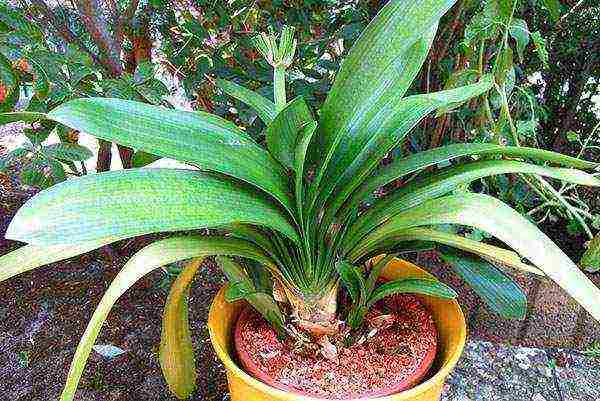 Under natural conditions, clivia grows on fertile, humus-rich soil. Accordingly, a drainage layer is placed in the pot and a pillow from the substrate is poured:
Under natural conditions, clivia grows on fertile, humus-rich soil. Accordingly, a drainage layer is placed in the pot and a pillow from the substrate is poured:
- peat - 1 part;
- humus - 1 part;
- sod land –2 parts.
Additionally, perlite, or vermiculite and sand is added to the ground for clivia. Superphosphate in granules poured into the bottom of the pot will ensure better root development and abundant flowering.
Experienced flower growers use ready-made soil for orchids when transplanting. In such a substrate, the roots become greasy, the plant develops and blooms faster.
The pot for transplanting needs to be selected only slightly larger than the previous one. The choice of ceramic or plastic dishes depends on how easily and without injuries the plant is removed. Smooth inner plastic surfaces are preferred for this plant. The conical shape of the vessel will help the easy extraction of the plant. Drainage holes should allow good drainage of irrigation water.
Clivia transplant at home
Unless there are circumstances that require immediate plant transplantation, clivia is transplanted after flowering, during a dormant period.
If you are not going to propagate the clivia from seeds harvested from the plant, the flower arrow should be cut off. The plant is greatly weakened, giving strength to the production of offspring.
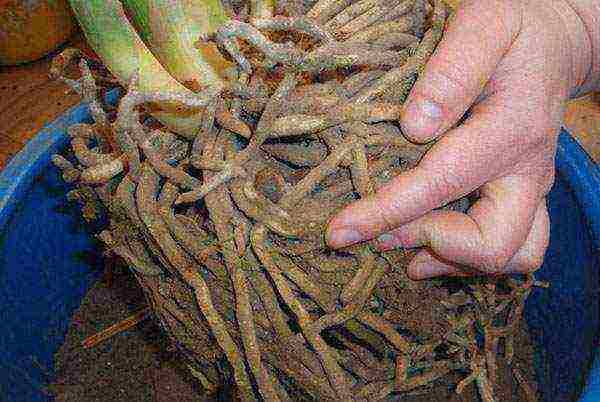 When transshipment, it is necessary to preserve the roots, since the wounds can become infected and the roots will begin to rot, especially since the plant likes abundant watering. Young plants are transplanted annually, while the old ones only change the top layer of the loosened soil. When planting in a new container, the soil layer should not cover the base of the leaves. Constant dampness in this area will lead to decay.
When transshipment, it is necessary to preserve the roots, since the wounds can become infected and the roots will begin to rot, especially since the plant likes abundant watering. Young plants are transplanted annually, while the old ones only change the top layer of the loosened soil. When planting in a new container, the soil layer should not cover the base of the leaves. Constant dampness in this area will lead to decay.
If the roots are damaged during transshipment, they must be carefully treated with charcoal dust. The planted plant is shaded and creates comfortable conditions for rapid rooting.
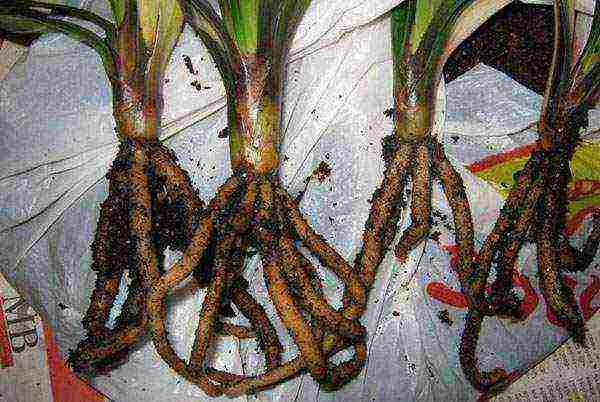 At the same time, new offspring can be gently disentangled from the mother plant for the reproduction of the clivia. An indispensable condition will be the presence of at least four leaves in young plants. Only under this condition can the roots feed the young plant.
At the same time, new offspring can be gently disentangled from the mother plant for the reproduction of the clivia. An indispensable condition will be the presence of at least four leaves in young plants. Only under this condition can the roots feed the young plant.
You can plant young children in separate cups, with a bottom hole and a drainage layer. In this case, the diameter of the dish should be about 7 cm in diameter. You can root two or three plants in one pot. When clivia is reproduced at home by children, it will give a flower arrow for the second or third season.
It is considered important not to create a dormant period of two years for young plants. They must intensively throw out the leaves, accumulate a supply of food in order to bloom faster. Continuous watering and feeding will speed up the formation of the arrow.
Getting clivia from seeds.
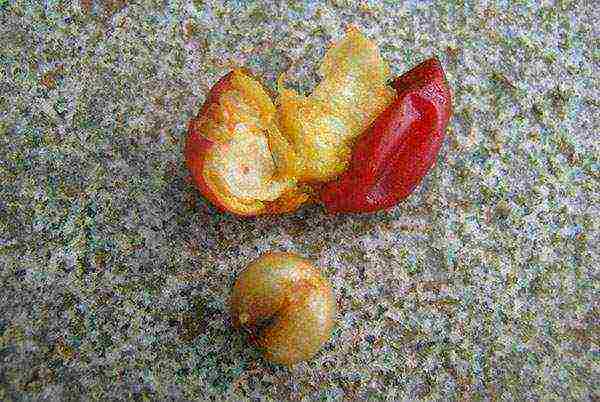 Seed propagation requires more patience. Seeds can be grown independently when the mother plant is eight years old. They need to be sown in a school made of peat, turf and sand. The seeds will hatch in six months. Favorable time for sowing from October to April. All the time the container is kept warm and slightly moisturized. After the leaf comes out, the plants are transferred to separate cups.
Seed propagation requires more patience. Seeds can be grown independently when the mother plant is eight years old. They need to be sown in a school made of peat, turf and sand. The seeds will hatch in six months. Favorable time for sowing from October to April. All the time the container is kept warm and slightly moisturized. After the leaf comes out, the plants are transferred to separate cups.
Seeds germinate if they were kept wet in the berry. So that the berry does not dry out, it is kept on a cut stem until the time of sowing.
There is also a faster way to get seedlings - in a warm place in a damp cloth. The hatched seeds are sown in separate cups.
After the seedlings grow up, they are transplanted into large cups and more nutritious soil.For two years, three-time transplanted plants without a dormant period gain mass and roots. They are fed, kept at a temperature of 20 C. With seed reproduction of clivia at home, flowering will occur in the fourth year of the plant's life.
Video about the propagation of clivia by seeds
A plant like Clivia (Clivia) is directly related to the Amaryllidaceae family. In the wild, it can be found in South African humid subtropical forests. This herb is a perennial plant with very long leaves that are collected in a rosette.
The beautiful flowers of this plant collected in inflorescences, as a rule, are colored yellow, orange or red. There are about 10–20 of these bell-shaped flowers on one inflorescence. Their blooming occurs gradually, and the flowers themselves hold on for quite a long time. Moreover, one clivia has several flower arrows.
If this flower grows indoors, then its flowering, as a rule, begins in February or March. If the clivia is large enough and well cared for, it can bloom 2 times in 1 year.
It also has long, shiny leaves that are dark green in color. The bases of the leaves are thickened, and they are in very tight contact with each other (thanks to this, they look like a bulb). And they are located on the rhizome. Interestingly, this plant lacks a bulb, which is a significant difference from other amaryllis. Clivia also has a fleshy and very succulent root system. It is capable of accumulating reserves of nutrients and fluids.
This plant is quite undemanding. He does not have any special requirements for illumination or humidity. It feels best on the windowsills of windows located in the western, eastern or northern part of the room.
As a home plant, flower growers most often choose a variety such as cinnabar clivia (Clívia miniata), it is also called the cinnabar vallota (Vallota miniata), as well as the beautiful clivia either noble (Clívia nobilis).
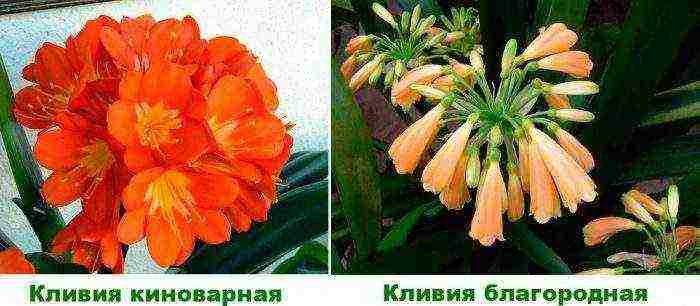
A variety such as cinnabar clivia has gained popularity as a medicinal plant. For the manufacture of medicinal drugs, the whole plant can be used as a whole, or rather, both leaves and roots. So, the local population of Zulu with the help of clivia rhizomes treats fever, and also manufactures a remedy that can significantly reduce pain from a poisonous snake bite.
However, special care must be taken when treating clivia cinnabar with rhizome. The fact is that it contains some alkaloids, which makes it very toxic. Therefore, without special knowledge, it is better not to self-medicate.
Home care for clivia
It is quite simple to care for the clivia, the main thing is to remember that it is necessary to disturb it only as a last resort. So, it is not recommended to rearrange it, loosen it, replant it, polish it, and also cut it off.
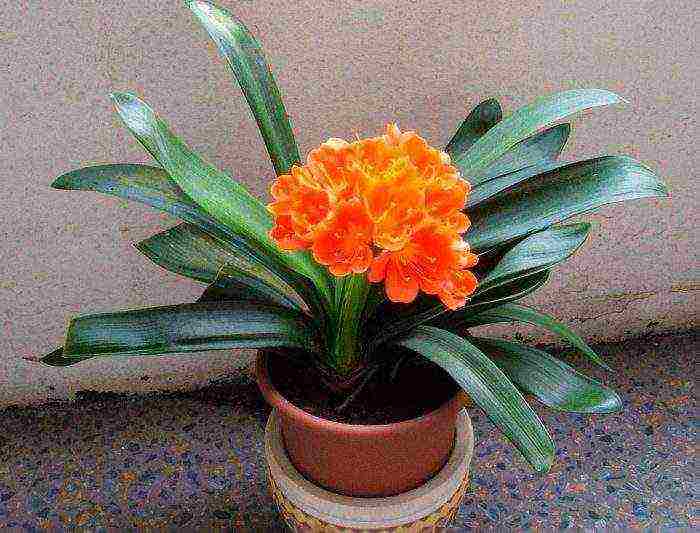
Illumination
This plant reacts extremely negatively to direct rays of the sun, therefore it needs to be shaded from them. It feels great on window sills located in the east or west of the room. It can also be placed on the northern windowsill, but it is worth considering that the growth of clivia there will slow down and, most likely, flowering will not occur at all. In the warm season, it is recommended to move the flower to the street and choose partial shade for its placement.
Temperature regime
This flower does very well at normal room temperature. During the growing season, it is best to provide the plant with a temperature in the range of 20-25 degrees. During the dormant period, which begins in October, the air temperature in the room should be reduced to 12-14 degrees. After the clivia has a peduncle, it is placed in a room with an air temperature of 18–20 degrees.
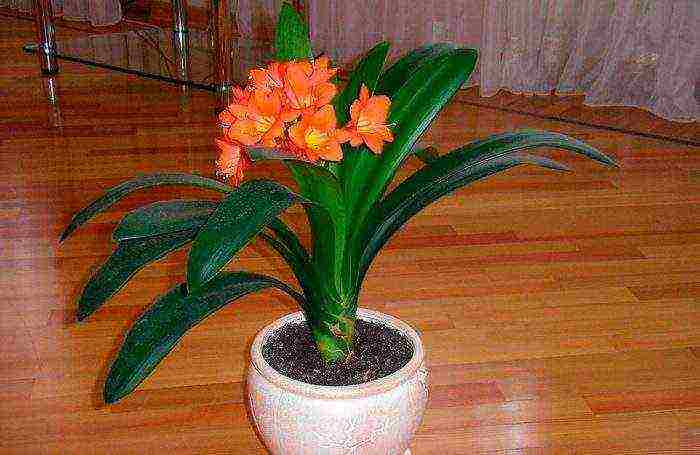
Humidity
This flower does not have any special requirements for air humidity.
How to water
Water this plant in moderation, while ensuring that no water accumulates in the pan. During the dormant period, the flower is not watered at all, or they do it extremely rarely. After the buds begin to form on the peduncle, they begin to water the clivia abundantly and use extremely warm water for this.
Top dressing
It is necessary to feed the plant only during its flowering, as well as active growth. So, during flowering, fertilizer should be applied to the soil 2 times a month. In this case, fertilizers are selected that contain a small amount of nitrogen. This is because nitrogen can cause no second bloom, but foliage will grow very well.
Features of the rest period
Clivia definitely needs to provide a dormant period, because this is the key to regular and very good flowering. As a rule, it begins in October or November. The duration of this period is 2-3 months. In order for the plant to go into a dormant period, it must not only be placed in a cool room in the autumn, but also significantly reduce watering.
Fertilizers cannot be applied to the ground at this time. The recommended temperature in the room containing clivia is 10-12 degrees. However, if this is not possible, then at ordinary room temperature, the rest period proceeds quite well. In the event that the plant begins to throw off the leaves, it needs to be watered urgently (quite a bit).
Flowering features

While the plant is young, it blooms only once a year. After the flower becomes an adult, it will bloom twice a year (but this is if it is completely healthy). At the end of the dormant period, a flower arrow forms at the clivia, and after it reaches a height of 10-15 centimeters, the flower is moved to a room with normal room temperature and provided with abundant watering. It is not recommended to touch this plant until the flower arrow has fully grown, at this time it is only allowed to water it (infrequently and a little). It should be borne in mind that a sharp change in temperature can provoke a stop in the development of buds. In the case when the flower was at room temperature during the dormant period, he just needs to increase watering. At the same time, you need to water the plant with warm water in order to activate the growth of the peduncle. It is forbidden to move the flower pot during the budding and flowering period.
When the flowering is over, do not stop watering and fertilizing the flower. In the last summer months, flowering may return. In the event that the peduncle does not appear, the plant can be provided with an artificial rest period. To do this, it is rearranged in a dark and cool place, not fed, and watering is extremely rare. After a few weeks, you will be able to see that the clivia has developed a peduncle.
It is worth knowing that flowering can occur without a dormant period, and that's all, because this plant is extremely unpretentious. It is capable of adapting to almost any conditions, and at least once a year the clivia will bloom. It is noteworthy that flowering occurs each time at a different time.
You can get seeds from a plant, but artificial pollination is used. Green fruits take on a red-orange hue only after a year. At the same time, you need to know that during fruiting, the plant must be regularly fed. The seeds can only be harvested after the fruits are soft.
Earth mixture
For this plant, a soil mixture consisting of leafy and soddy soil, as well as sand, taken in a 2: 2: 1 ratio, is suitable. You can also mix humus, turf and peat soil, taken in a 1: 2: 1 ratio, and add a little sand. Don't forget good drainage.
How to transplant
The transplant is carried out only when absolutely necessary, for example, when the roots cease to fit in the pot. It is better to limit yourself to transshipment in order to protect the roots from damage that can lead to rotting of the root system, especially if the soil is too moist. The pot must be taken a little larger than the previous one.
How to propagate

Propagated by side children and seeds. Lateral children are disconnected from the adult flower during transplantation, while they must have at least four leaves. For planting, use small pots filled with a mixture of sand and leafy soil. Water moderately. Flowering will come in 2 or 3 years.
Seeds are sown shortly after they ripen. For sowing, a mixture of sand and turf soil is used. Seedlings will appear in 1–1.5 months. The transplant is carried out after the appearance of 1 leaf. Growth is very slow, and such clivia will bloom only after 3 or 4 years.
Pests
A mealybug or scale insect can settle. To destroy them, wipe the plant with a sponge soaked in soapy water and treat with actellik solution.
Possible problems
- Short peduncle - low air humidity or too cold.
- The leaves are very pale - lack of nutrients. Feed the flower.
- Peduncle growth has stopped - most likely, a prolonged rest period. Water the plant more often with warm water (temperature no higher than 40 degrees).
- The appearance of reddish or white spots on foliage - sunburns. Move to a shaded area.
- Flowering does not come - lack of light or high air temperature. Give the plant a full dormant period.
Video review
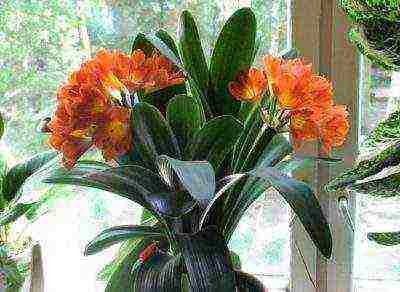
Clivia is an elegant and stylish houseplant, which is very unpretentious, and, under favorable conditions, pleases with its flowers from year to year. The leaves of its lush halo surround a bouquet of inflorescences of bright joyful tones.
Clivia usually blooms in the last third of winter and brightens up snowy cold days with a piece of summer greenery and flowering. After a certain time, the clivia will need to be transplanted. The clivia roots are carefully freed from the soil and transferred to a new pot, covered with fresh soil, since the old one is already depleted. Next, we will tell you in detail about how to plant clivia at home.
…


